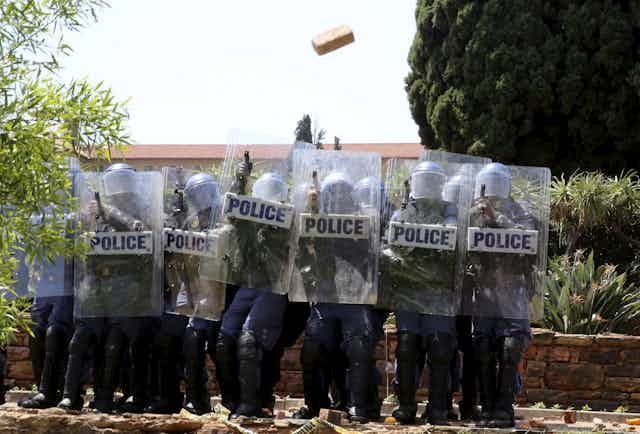In the wake of the student protests on South African campuses, universities need to engage in some critical reflection. Did their responses protect the constitutional rights and freedoms of those engaging in the protests, as well as those not wishing to? How did university responses relate to police responses? And were police responses proportional to the level of threat posed to public safety?
Sadly, many universities did not adequately rise to the challenge, and some engaged in deeply worrying violations of students’ rights and freedom.
Freedom of assembly
Although not apparent from the media coverage, the protests were overwhelmingly peaceful and highly disciplined, even if many were disruptive.
But all protest involves some level of disruption, and disruptive protests are not necessarily violent. Disruption may, in fact, be the only way in which protestors can make institutions hear their voices.
Universities need to tolerate peaceful disruptions, as this option is by far the lesser evil by far. The alternative – namely to limit fundamental assembly, association and speech rights – is much more drastic and can have far-reaching consequences for society.
No-one should be criminalised for participating peacefully in a protest, even if the authorities have not been notified as per the Regulation of Gatherings Act, which gives effect to the constitutional right to assembly, demonstration and picket. Such gatherings should not be dispersed.
But many universities may ask: what about the thug element that infected some protests? Individuals that engage in thuggery should be held liable for their actions, as they are infringing the rights of others. This liability, however, should apply to the individual, not to crowds.
Universities may also argue that they are private actors, and that they can decide whether to grant or deny the right to assemble. But even private actors have a duty to promote conditions for the exercise of this right.
In the case of “private spaces” used for public purposes, such as universities, the responsibility to enable fundamental rights becomes even greater. Universities are also duty bound to enable protests at places that are most meaningful to the protestors, which is most likely to be on campus.
The “publicness” of university campuses makes it particularly inappropriate for them to invoke trespass laws, as these laws typically apply to private property.
Some university administrations were more open than others. Largely, however, a preliminary assessment suggests that universities managed responses to the protests poorly, resorting all too easily to inappropriate “law and order” approaches.
Disproportionate force
These inappropriate responses set the tone for the police, who often used disproportionate force to break up even peaceful but disruptive protests. At most universities there was little evidence of prevention and precaution measures. Listening skills were in short supply, even as students made visible gains.
As the struggles intensified, poorly drafted mass court interdicts flew thick and fast. The fact that several universities abandoned these before their return dates suggest that the threats were overstated, and that they would have been difficult to defend when the respondents were given the right to reply.
And the University of the Witwatersrand’s reversion to the 1979 Trespass Act was particularly odious. The apartheid-era law prohibits people from entering and occupying land without the permission of the land owner. Under apartheid it was used to protect white ownership of often illegitimately acquired “private” property such as land.
Wide-ranging mass interdicts can lead to the over-policing of protests. And indeed the police enforced the overbroad interdicts on and around campuses. While they claimed to be operating according to the minimum force doctrine, the police used crowd control measures that were more appropriate for policing armed thugs, rather than unarmed students.
The harmful effects of rubber bullets is well known, but stun grenades too can cause injury and should be used as a last resort. This did not appear to be the case in relation to the student protests.
Private security option carries risks
Police violence was so severe in the Western Cape that the Legal Resources Centre, a legal non-governmental organisation focused on human rights defence, sought an interdict against the police.
The police also arrested people indiscriminately in the wake of protests. At the Union Buildings march protestors were arrested and then released after being detained. This was in violation of their rights.
Some universities increased their private security presence to avoid making the politically sensitive decision to bring the police onto campus. But this decision was likely to create more problems than it solved, as these companies are viewed as being less accountable for their actions than the police.
Eyewitness accounts and footage of private security guard throwing what appear to be rocks at students at the University of Johannesburg, underlines the problem.
In the wake of the student protest at Parliament in Cape Town, the government activated the National Joint Operating Centre, the government body that co-ordinates joint work of the police, intelligence agencies and the military. This decision opens the door to the army being deployed against the students in the future to assist the public order police.
Government spies have also stated their intention to “increase ground coverage”. This makes it more than likely that spies are present on campuses and are infiltrating student organisations.
Overall, the #feesmustfall movement has brought massive gains for democracy in South Africa. As relatively free spaces for enquiry, universities have a public duty to fight South Africa’s slide into a national security state, not facilitate it. If they don’t, even these relatively free spaces may not last long.
The writer thanks the Socio-economic Rights Institute for legal advice on this article.

